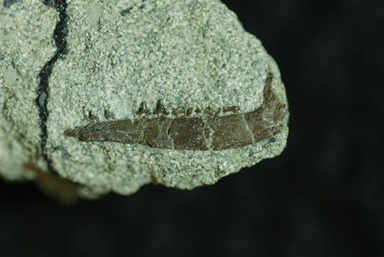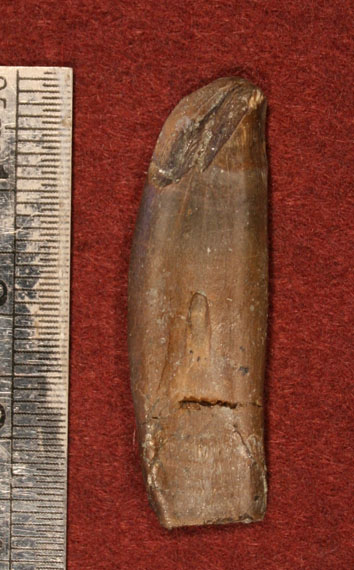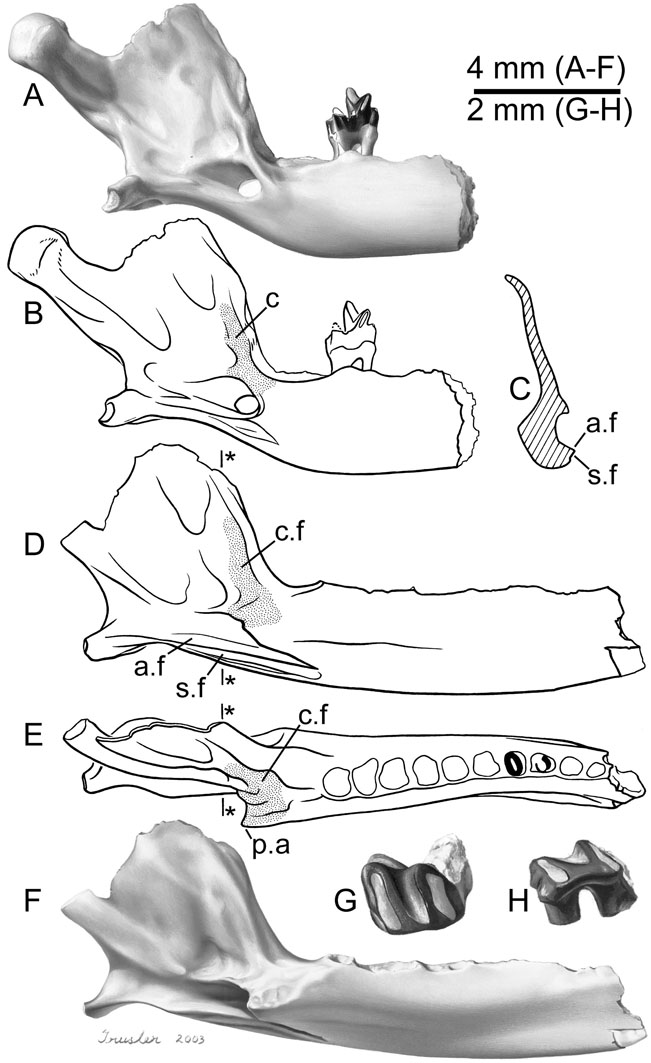|
|
|
2009 annual report
The Dinosaur Dreaming 2009 annual report was released on Saturday 31st October at the Friends of Dinosaur Dreaming dig update meeting, held at Museum Victoria in Melbourne.
The report included contributions from head researchers Dr Tom Rich and Professor Patricia Vickers-Rich as well as members of the Dinosaur Dreaming crew.
Excerpts from Dr. Tom Rich’s report below reflect the amount of research that is currently taking place on the Dinosaur Dreaming project. The future prospects for the project are looking very promising as new areas open up.
 Jacqui's mammal jaw
Excerpts from “Vertebrate Fossils by Dr. Tom Rich.”
The plan at the moment is to publish in the next few years, scientific articles about all the dinosaur material collected in Victoria since 1978. Many of these fossils have already been described, some more than once. But after 31 years, all of them need to be out there for professional colleagues around the world to be able to know about what has been found in this State.
From Victoria, there are four different types of small theropod teeth all known as isolated specimens much to the frustration of Lesley who yearns for a jaw or skull fragment of at least one of these theropods with the teeth in place. Such a specimen could make it possible to assign a generic and specific name to one of these small species that we know on the basis of isolated teeth are there but are insufficient to give a scientific name to. In the meantime, Steven Salisbury, Phil Currie of the University of Alberta, Edmonton, Pat Vickers-Rich and myself have a manuscript describing the approximately 80 such isolated teeth now known.
 Theropod tooth with root
All of this Victorian theropod material plus what has been described before, indicates a diversity of this group in this State comparable to that of the hypsilophodontids. The Victorian material of the hypsilophodontids [= euornithopods = non-dryomorph iguanodontians] is being currently reviewed and described by Matthew Herne of the University of Queensland for his Ph.D. dissertation.
Progress on the mammalian front was made this past field season when Jacqui Tumney found a jaw of Bishops whitmorei. Her discovery shows for the first time what the anterior part of the jaw was like. Although the tooth is gone, there is a large alveolus for the canine. An enlarged canine for this species fits well with the premolar and molar dentition behind in showing that B. whitmorei was likely to be a very active predator on what were rather tiny prey, perhaps primarily insects and worms.
While Bishops and its co-familial Ausktribosphenos have generated much controversy over the years as to their placement in the mammalian family tree, the other mammal from the Flat Rocks site, Teinolophos, a monotreme, has been equally controversial and thus exciting. In the living monotremes, the echidna and platypus, a single bone forms the lower jaw as it does in all other mammals. In Teinolophos and reptiles, a number of bones form the lower jaw. In fact the condition in the jaw of Teinolophos is so different and, for this reason, so unexpected, that there are people who have asserted in the scientific literature that those reptilian-like extra bones do not even exist! For this reason, teaming up with James Hopson of the University of Chicago and Pamela Gill of the University of Bristol, Pat Vickers-Rich and I are documenting that Teinolophos does show the reptilian jaw condition.
After more than 30 years of searching for and collecting dinosaurs and other fossil vertebrates in Victoria, two new approaches to be trialed in the years to come have been recognised as feasible in the past twelve months.
As explained elsewhere in this report, Tony Martin has recognised what he thinks are likely to be dinosaur burrows exposed in the coastal outcrops of the Otway Group. Building on this, the thought is for Tony to prospect all the coastal outcrops of both the Otway and Strzelecki groups, mapping those structures he interprets as possible dinosaur burrows. Once that is done, an assessment will be made of which, if any, of these burrows should be excavated to attempt to recover dinosaur bones within them. Tony participated in a study of the first dinosaur burrows recognised anywhere in the world. The burrow structure central to the study carried out in Montana had the remains of two juveniles and one adult hypsilophodontid in it.
A trip I made in June to the area of China known to yield feathered dinosaurs showed a remarkable resemblance of some of the fossil-bearing units there to the well known Koonwarra site. Koonwarra is a locality about 17 km north and east of Inverloch where fossils the same age as Flat Rocks occur in a quite different geological setting. Instead of being a sandstone laid down in stream deposits, at Koonwarra the fossils occur in much finer grained shales and claystones deposited in the quiet waters of a lake bottom. In the similar deposits in China, the dominate fossils are small fish, arthropods, and plants. Those are exactly the same three groups that dominate the Koonwarra assemblage. And although feathered dinosaurs have not been found yet at Koonwarra, that may be simply a lack of effort. The amount of area excavated in China to recover a single feathered dinosaur at the site where I saw specimens in place was far greater than all the area ever excavated at Koonwarra. Feathers are not common as fossils as they usually rot away. A few isolated ones have been found at Koonwarra. This suggests that the similarity to the Chinese occurrences may well be significant.”
 Scientific drawing of Teinolophos jaw by Peter Trusler
A full copy of the Dinosaur Dreaming 2009 annual report can be obtained by becoming a “Friend of Dinosaur Dreaming”.
|